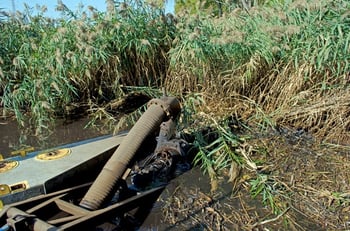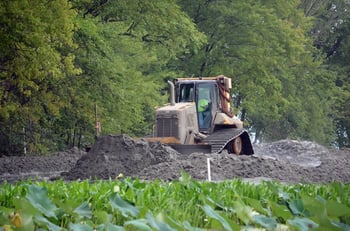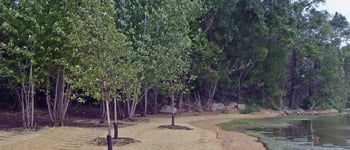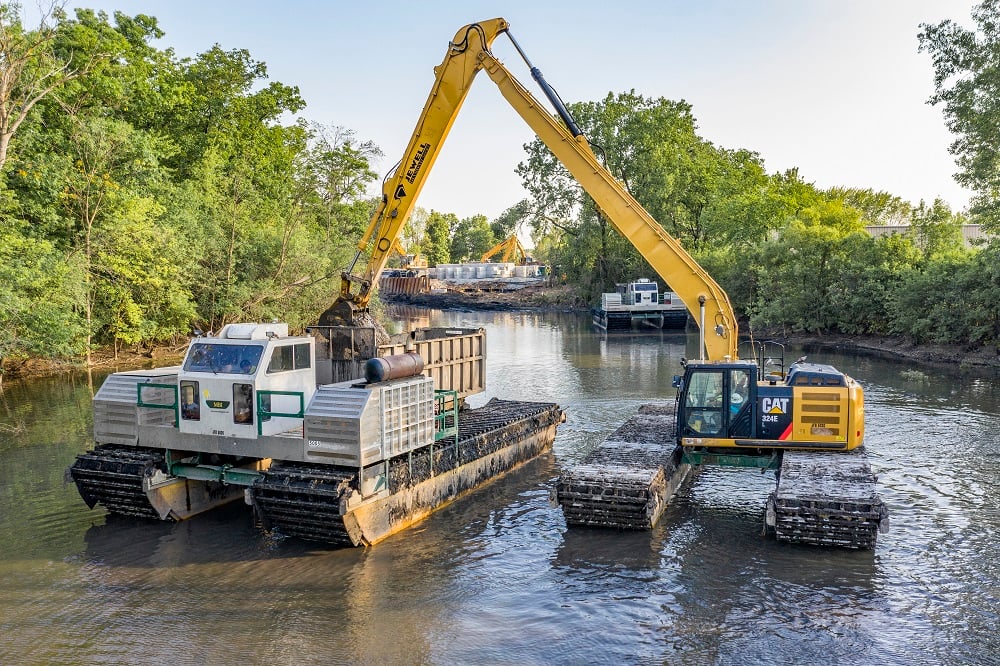Our experience in wetland habitat restoration began decades ago with the Upper Mississippi River Restoration Program (UMRR), the largest restoration program ever undertaken on a major waterway worldwide. Since then, restoring marshes, wetlands, and highly sensitive ecosystems along inland and coastal waters nationwide has been a main initiative.
It is rare when a wetland remediation project occurs without substantial restoration work. When removing impacted sediments, removing the surrounding flora and vegetation is often necessary. When the excavation is completed, the area must be restored so that it can once again become a vibrant habitat for native plants and animals.
There are 4 essential steps to carrying out wetland restoration.
1. Treatment of Invasive Species
 Even before excavation work occurs, the steps to remove invasive species begin. This is often done with herbicide treatment, controlled burning, or even mowing and trimming. Herbicide applications are the most common and should be performed in a manner that has the least environmental impact on native species.
Even before excavation work occurs, the steps to remove invasive species begin. This is often done with herbicide treatment, controlled burning, or even mowing and trimming. Herbicide applications are the most common and should be performed in a manner that has the least environmental impact on native species.
When treating areas, minimizing any particle drift and off-target damage to local fauna and flora is essential. By utilizing tactics such as modifying spray droplet size and selecting nozzle tips appropriate for specific environmental factors such as wind speed, wind direction, temperature, and humidity, you drastically reduce damage to non-invasive plants. Also, consider posting public notices indicating areas of recent herbicide application, including information that clearly delineates the treatment area, the date of treatment, appropriate precautions to be taken, the date when re-entry is safe, and a phone number for additional information.
2. Placement of Clean Sand and Sediment
 After the excavation and removal of impacted sediments have been completed, we begin rebuilding the wetland using clean materials. Rebuilding efforts can include the installation of clean sand, engineered caps, and organic black dirt. This material can come from nearby borrow sites or is brought in from distant locations.
After the excavation and removal of impacted sediments have been completed, we begin rebuilding the wetland using clean materials. Rebuilding efforts can include the installation of clean sand, engineered caps, and organic black dirt. This material can come from nearby borrow sites or is brought in from distant locations.
The placement of clean material can be facilitated in several ways. It can be brought in by dump truck, barge, amphibious equipment, or even be pumped hydraulically. Each project must be evaluated to determine which method is the most economical and the least damaging to undisturbed areas.
3. Seeding and Planting
After the new material has been placed and graded, it is imperative to seed the area and plant native vegetation and trees quickly. This will ensure a quicker recovery, and it will help prevent erosion.
 Much like a surgical procedure, wetland restoration requires time for recovery. Grasses and shrubbery may take a year or two, while the reintroduction of trees, such as willows, may take several years.
Much like a surgical procedure, wetland restoration requires time for recovery. Grasses and shrubbery may take a year or two, while the reintroduction of trees, such as willows, may take several years.
4. Maintenance and Monitoring
Once restoration is complete, there is typically a period of time when the contractor, engineer, or owner is required to monitor the wetland. Periodic maintenance is needed to replace plants that don’t grow or invasive species that move in while the native plants are taking root.
Maintenance includes, but is not limited to, selective herbicide application, mowing, reseeding, replanting, and watering. Any leftover or regrown invasive species can be controlled through physical removal, mowing, and spot herbicide application. Maintaining the wetland areas is a continuous process throughout the growing period until the vegetation takes hold.
Amphibious Equipment Aids Wetland Restoration
Amphibious equipment can be used in a variety of ways to aid the restoration of a wetland. When the water is too deep or the ground is too unstable to use traditional equipment, or when the water is too shallow for barges, amphibious equipment is the solution. This equipment has extremely low ground pressure and can access areas of the wetland without the need for temporary roads or dewatering. The use of amphibious equipment can also reduce the overall damage in areas where excavation is not needed. In traditional restorations, temporary roads or levees are built. When these structures are removed, the areas in which they were located must be restored as well. Amphibious equipment can aid in treating invasive species, excavating impacted sediments, restoring clean sand and sediment, re-planting, and monitoring.
Wetland restoration takes time, and though the first three steps can be accomplished fairly quickly, the long-term success of restoration will depend on the effort put forth in the last step of maintenance and monitoring. This is a crucial step in the management of a restored wetland, and when done well, the wetland will continue to be a vibrant natural habitat for many species of plant and animal life for generations to come.


